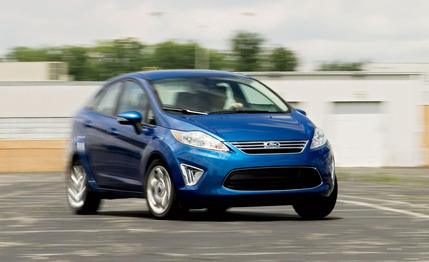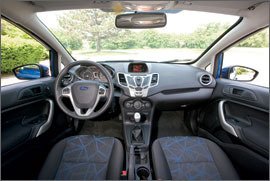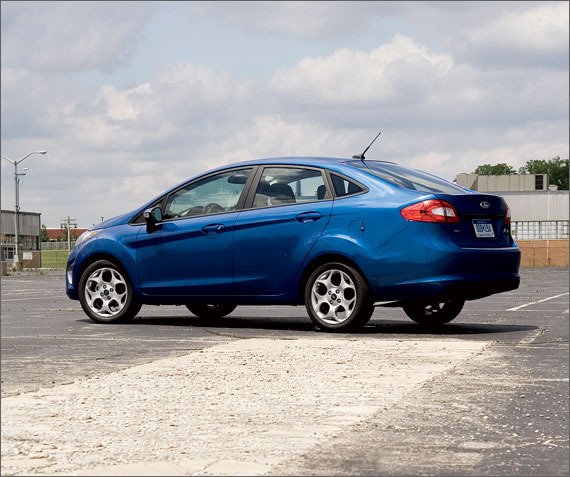
 Short Take Road Test
Short Take Road Test


One of the small but brilliant stars of the 2007 Frankfurt auto show was a three-door hatchback concept that looked like the automotive equivalent of a piranha—small but with a pretty fierce bite.
Ford called it the Verve, but it was clearly a tease for the next generation (number six) of the Fiesta. And when high fuel prices provoked a crescendo in U.S. subcompact sales, Ford decided to bring the Fiesta back to this market, its first appearance here since 1980 and also the company’s first North American subcompact since the unlamented departure of the Kia-supplied Aspire in 1998.
Our initial encounters with Euro-spec Fiesta five-doors, including a New York–to–Seattle drive, were positive. But this is the Fiesta that Ford sees as the volume-selling version for the U.S., a formal sedan assembled in Cuautitlán, Mexico.
Is disappointing too strong a word? The sedan—it will be offered only in North America and China—shares the hatchback styling as far as the A-pillars, with the addition of Ford’s U.S. three-bar grille. From there, however, it loses the five door’s sassiness, as well as the hatchback’s cargo versatility.


Something else that’s been lost—okay, diluted—is the Euro Fiesta’s performance. The rack-and-pinion steering is quick (2.5 turns lock-to-lock), and transient responses are brisk, but braking and skidpad numbers aren’t as good as those of the Euro five-door tested last year [September 2009].
Blame the tires—all-season Hankooks (195/50R-16) versus Michelin Pilot Exalto PE2s—as well as mass. Last September’s five-door weighed a lissome 2462 pounds. This sedan, which is 13.5 inches longer than the hatchback, weighs 2583.
Inevitably, mass also affects acceleration. Ford lists horsepower of the U.S. Fiesta’s 1.6-liter four as 120, two ponies more than the Euro version makes, but the sedan’s 0-to-60-mph (9.3 seconds) and quarter-mile (17.0 seconds at 82 mph) times were slower and would have been midpack in our most recent mighty-mite meshugas [“$15,000 Cheap Skates,” May 2006].
A six-speed gearbox would probably help. The top two gears in the Fiesta’s five-speed manual are pretty tall. (The Fiesta’s optional six-speed, dual-clutch automated manual may well outperform the manual.)
Aside from willing responses, the sedan’s virtues are a supple ride, supportive front seats (diminished by awkward seatback adjustment), a dashboard with a high-tech look (higher if it had a coolant gauge), a tilting and telescoping steering column, a sizable trunk (13 cubic feet, and rear seatbacks fold forward to expand capacity), satellite radio, and Ford’s Sync infotainment and communications system. Rear-seat space is tight, but a couple of adults can fit with cooperation from those up front, and there are hookups for child seats, enough airbags to cushion a ride over Niagara, and standard stability control.
Fuel economy should be a strong suit—the EPA forecasts 28 mpg city and 37 highway for the manual, 29 and 40, respectively, for the automatic—but, as usual, we underachieved: 29 mpg.
Though the U.S. product planners initially resisted, there will be a five-door Fiesta in Ford’s North American lineup. Fiesta prices start with a base four-door at $13,995 and culminate with the five-door SES at $17,795. Our well-equipped SEL sedan carried an MSRP of $16,995.


Will this be a little ambitious in the most price-sensitive of all segments? Even though the key competitors have yet to release their 2011 pricing, it’s safe to say that the Fiesta will be substantially more expensive than the Nissan Versa. And it’s also safe to say that we favor the hatchback. Ford’s conventional wisdom on this score—Americans don’t like hatchbacks—may be out of date. As evidence, consider the Nissan’s sales record with the Versa, one of the segment’s bestsellers: Over the last three full calendar years, Nissan sold 247,535 Versas, roughly two-thirds of them (165,404) in the more expensive hatchback body style.